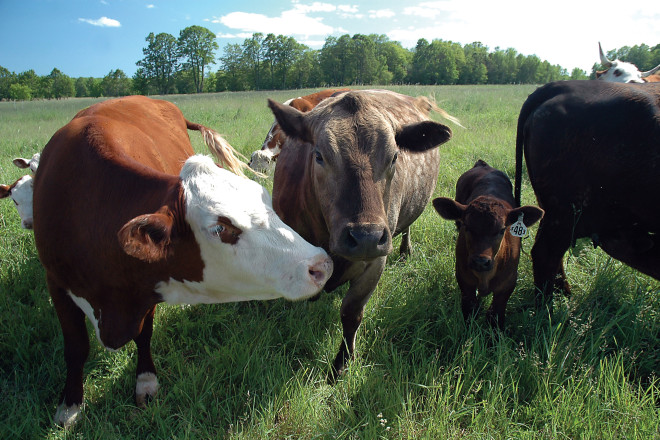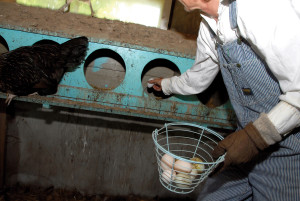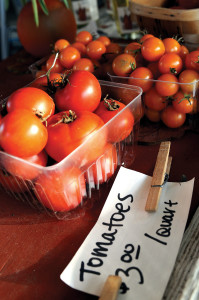The Door County 100-mile Diet Challenge
- Share
- Tweet
- Pin
- Share

In 2005, Vancouver residents Alisa Smith and J.B. MacKinnon decided for economic, environmental, and health reasons to only eat food grown within 100 miles of their home for one year. (On average, your food travels between 1,200 and 2,500 miles to reach you.) Their efforts have inspired many, including 14 Door County households who began a local challenge in June 2008. Virge Temme, one of the challenge organizers, says five of the 14 attempted a full-year, high-level commitment, while “others took this as an introductory ‘course,’ to start making connections with local food producers and become more conscious of where their food comes from and when it’s in season. Their commitments ranged  from one day a week, to four months, to simply ‘trying our best to do as much as we can.’” All were inspired by Sustain Door, a local non-profit with the mission of promoting economic, social, and environmental sustainability in Door County. One of the organization’s goals is to promote sustainable agriculture, which, notes Ann Hippensteel, another of the challenge organizers, “almost by definition requires food to be produced and consumed locally.”
from one day a week, to four months, to simply ‘trying our best to do as much as we can.’” All were inspired by Sustain Door, a local non-profit with the mission of promoting economic, social, and environmental sustainability in Door County. One of the organization’s goals is to promote sustainable agriculture, which, notes Ann Hippensteel, another of the challenge organizers, “almost by definition requires food to be produced and consumed locally.”
Ann began her year-long 100-mile challenge on June 21, 2008 with her daughter Sally, who participated fully for the first five months. Ann notes her own interest was partly “just to see if it could be done – I wanted to find the degree to which we can be self-reliant. We are so heavily dependent on trucks bringing things to us because of our geography.” A variety of other issues intertwined with food production and its transportation, such as water and air pollution, the scarcity of fossil fuels, and global warming, also motivated Ann.
One hundred percent of the food Ann and Sally ate – except when away from home – was grown, raised, and processed within 100 miles of Sturgeon Bay. They allowed themselves salt and yeast and other leavenings, but no other exceptions. This level of commitment “required a lot of research,” says Ann, “as we wanted to eat in a balanced, healthy manner. We started over three months ahead of time scouting out products grown and sold within 100 miles of Sturgeon Bay.”
 At the year’s end, Ann noted, “I feel pretty good, physically, and really hope not to gain back the 15 pounds I’ve lost or to start indulging in things I know aren’t really good for me. I hope to keep making my own bread, but I don’t think I’ll keep grinding the wheat myself! I’ll continue to can things, have my own garden, shop at the farmer’s markets. There are things I missed, though: salad dressing, olive oil, chocolate, tea, rice, oats, the convenience of just taking a slice of bread out of a bag and putting it in my toaster…If I don’t focus on the things I don’t have, though, I’m very satisfied – mostly the foods I eat are wonderful and I’ve had quite a sense of bounty. I think we need a more positive attitude: are we going to look at sustainability as deprivation, or as a challenge we need to step up to?”
At the year’s end, Ann noted, “I feel pretty good, physically, and really hope not to gain back the 15 pounds I’ve lost or to start indulging in things I know aren’t really good for me. I hope to keep making my own bread, but I don’t think I’ll keep grinding the wheat myself! I’ll continue to can things, have my own garden, shop at the farmer’s markets. There are things I missed, though: salad dressing, olive oil, chocolate, tea, rice, oats, the convenience of just taking a slice of bread out of a bag and putting it in my toaster…If I don’t focus on the things I don’t have, though, I’m very satisfied – mostly the foods I eat are wonderful and I’ve had quite a sense of bounty. I think we need a more positive attitude: are we going to look at sustainability as deprivation, or as a challenge we need to step up to?”
Virge also participated in the challenge for one year, but for different reasons. “I love cooking,” she explains, “and started from a position that was 90 percent culinary-motivated.” Virge’s primary goal was “to encourage public awareness of local, fresh, whole food sources because they’re healthier and more delicious. Growing and finding these sources is surprisingly easy,” she said. “Excluding a small handful of items I allowed from beyond 100 miles – coffee, cooking oils, and white flour – 90 to 95 percent of my family’s food prepared at home (or taken to potlucks) came from within eight miles of our home.” After eating only local grass-fed beef, free-range chickens and eggs, local pork and fish, and in-season produce for nearly two years, Virge comments, “I don’t know why anyone would prefer store-bought varieties, which are just flavorless in comparison. While some locally-grown produce was costly, nearly all of what I bought was reasonable. Our food expenses averaged $22 to $25 per week for two to three people, compared with over $110 per week we used to spend in the grocery store…the reduction of carbon emissions from shipping was icing on the cake.” 
Pam Harvey-Jacobs also took on the challenge for the full year, but says, “The true goal was to do this as a lifestyle adjustment, not a project with a timeframe. My goal was for 60 to 70 percent of my diet to be local – I wasn’t about to give up coffee, chocolate, frozen pizza, or Cinnamon Toast Crunch. Also, I work a demanding job with long hours and some traveling, so any meal I ate ‘out’ was exempt. What I didn’t want was to get to the end of the year and say, ‘Geez, I’m glad that’s over.’ My hope was that I could say, ‘Yeah, I can do this for the long run.’ The result is the latter.”
Pam observes, “I was much more attentive to the source of my food, even if it was outside the 100-mile region; I now buy pasta from Illinois, not Italy. We also noticed a significant decrease in the amount of garbage we produced, given the absence of most pre-packaged food. In the end, I believe I saved money even though the initial outlay during harvest season was high. After I had the food put up, my grocery bills dropped at least 50 percent, if not more. Eating locally is not an expensive undertaking, if you take advantage of what’s in season. And, I did not actually grow any of my own food; it all came from other sources.” Pam notes encouragingly, “The bottom line is, this challenge is do-able. Honestly, I totally believe that if I can do it, anyone can. And if someone says they’ll commit to 10 percent local, and that’s what’s do-able, I say, ‘Go for it!’ Not being able to do 100 percent is fine. Any percent is better than no percent.”
Resources and Further Information
Barbara Kingsolver’s excellent non-fiction book Animal, Vegetable, Miracle recounts her family’s efforts to eat locally-produced foods for one year. If you are interested in learning and doing more, her book provides useful advice, recipes, and information. If you aren’t interested, her book will educate, amuse, and probably inspire you to learn and do more.
The website www.100milediet.org contains information specific to the first chronicled 100-mile diet conducted by Smith and MacKinnon as well as useful general information for those seeking to explore the idea further.
The Sustain Door website (www.sustaindoor.org) 100-mile challenge link has information on local efforts and local food producers. Sustain Door member Ann Hippensteel also did an interview with Northern Spirit Radio (www.northernspiritradio.org; enter “Hippensteel” in their search engine) about her challenge experiences.


